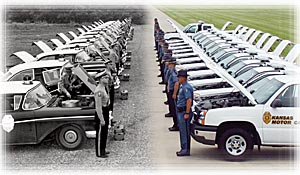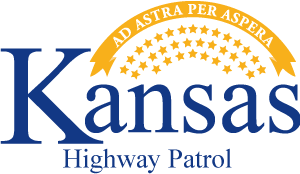The Patrol
 In 1933, the Kansas Legislature, Governor Alfred Landon, and Highway Department Attorney Wint Smith acted to halt the rampant bank robberies and crime sprees of the 1920s and 1930s. They created a force of 10 motor vehicle inspectors, the forerunners of Kansas troopers.
In 1933, the Kansas Legislature, Governor Alfred Landon, and Highway Department Attorney Wint Smith acted to halt the rampant bank robberies and crime sprees of the 1920s and 1930s. They created a force of 10 motor vehicle inspectors, the forerunners of Kansas troopers.
The Legislature officially organized the Kansas Highway Patrol in 1937. A superintendent, assistant superintendent, and 45 troopers were hired to reduce crashes by enforcing traffic, vehicle and license laws. Kansas City, Kansas, Police Department veteran Jack B. Jenkins was the first superintendent.
The governor appointed the superintendent and the superintendent appointed the rest. All appointees had to pass a physical exam and be U.S. citizens, at least 24 years of age, of good health and moral character, and without a criminal record. The 1941 Kansas Civil Service Law affected appointment procedures, but as late as 1945, half of the appointees had to belong to the governor’s political party, and the other half had to come from the party that placed second in the gubernatorial race.
In the 1950s, the Patrol began to police the turnpike for the Kansas Turnpike Authority, and Protective Services began with one trooper providing the governor’s ground transportation. The recruit school moved from the Kansas State Reformatory in Hutchinson to the University of Kansas in Lawrence. Increasingly, troopers patrolled alone. Before, they always rode in pairs.
In the 1960s, each trooper was assigned a patrol car to improve roadway coverage and access to the Law Enforcement Teletype System and National Crime Information Center improved the Patrol’s communications. The first promotional examinations were given, and the deactivated Schilling Air Force Base in Salina became the Patrol’s Training Center. Additionally, the Motor Vehicle Department began examining license applicants, releasing trooper-examiners for other duties.
In 1976, the Patrol gained authority over the Capitol Area Security Patrol, which is now the Capitol Police, also known as Troop K. In 1988, authority over the Motor Carrier Inspectors passed from the Department of Revenue to the Patrol. Then in 1994, the Training Academy, or Troop J, moved to the former Marymount College campus in Salina.
The first female troopers joined the Patrol in 1981. Today, the agency actively recruits women and men to be troopers and to fill other uniformed and civilian positions. Besides troopers, the agency employs capitol police officers and guards, motor carrier inspectors, communications specialists, vehicle identification number inspectors, and civilians in a variety of other support positions.

